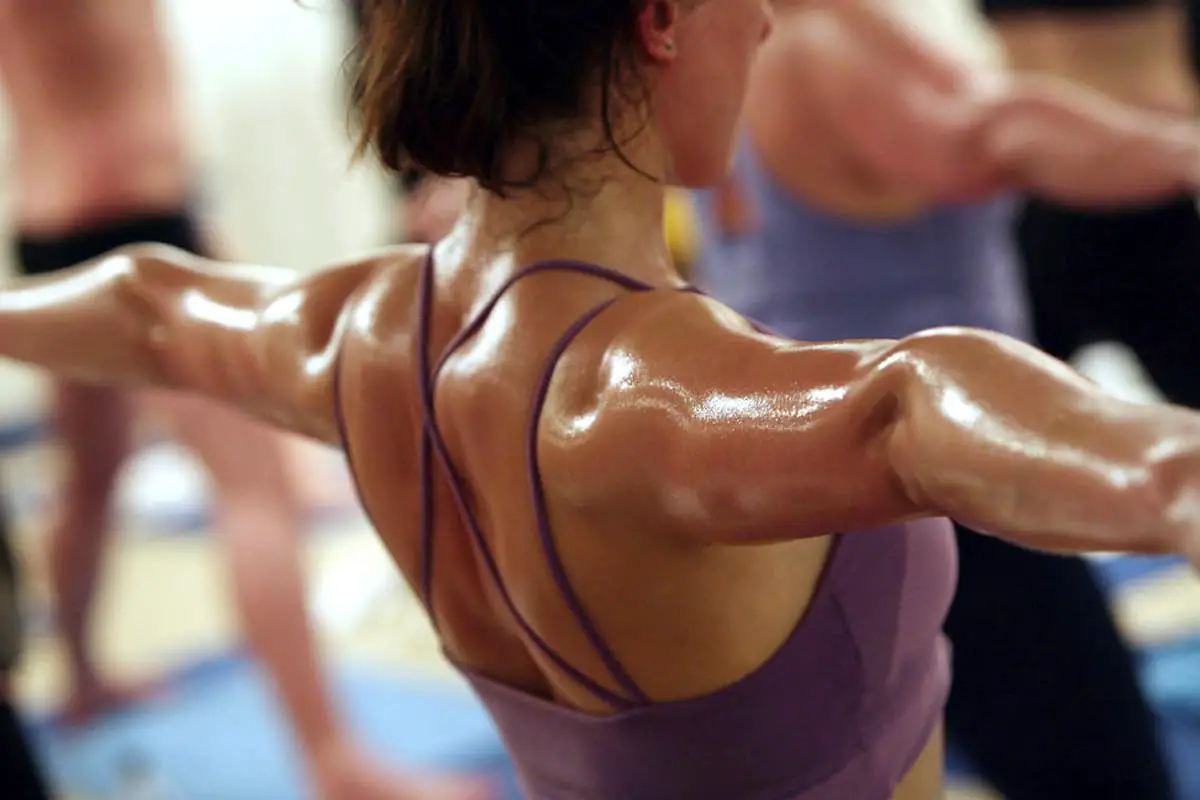In the last few decades, Yoga became one of the most popular practices and types of exercise. A distinct branch of yoga practices is the so-called Hot Yoga or Bikram Yoga. It has almost all of the benefits of traditional hatha yoga, while also providing a more intense workout since it’s practiced in a hot, humid atmosphere.
Do you want to learn more about hot yoga? Maybe you’re thinking of enrolling in hot yoga classes? If so, read on. This article is a full guide to what hot yoga is, how it’s practiced, its benefits and concerns, and preparation before starting hot yoga.

What is hot yoga?
The term hot yoga represents any set of yoga poses (asanas) that can be found in other types of yoga practices. The reason why it’s called “hot” is due to it being practiced in a room that’s heated above normal room temperature i.e. anywhere between 80 and 100°F (27 and 38°C) and with a lot of humidity.
With an atmosphere like that, hot yoga provokes sweating, burning calories, and faster muscle toning, as other kinds of exercising do.
In contrast to other yoga types, which are known to be slow, quiet, and tranquil, hot yoga might include music, clapping, and more peer communication.
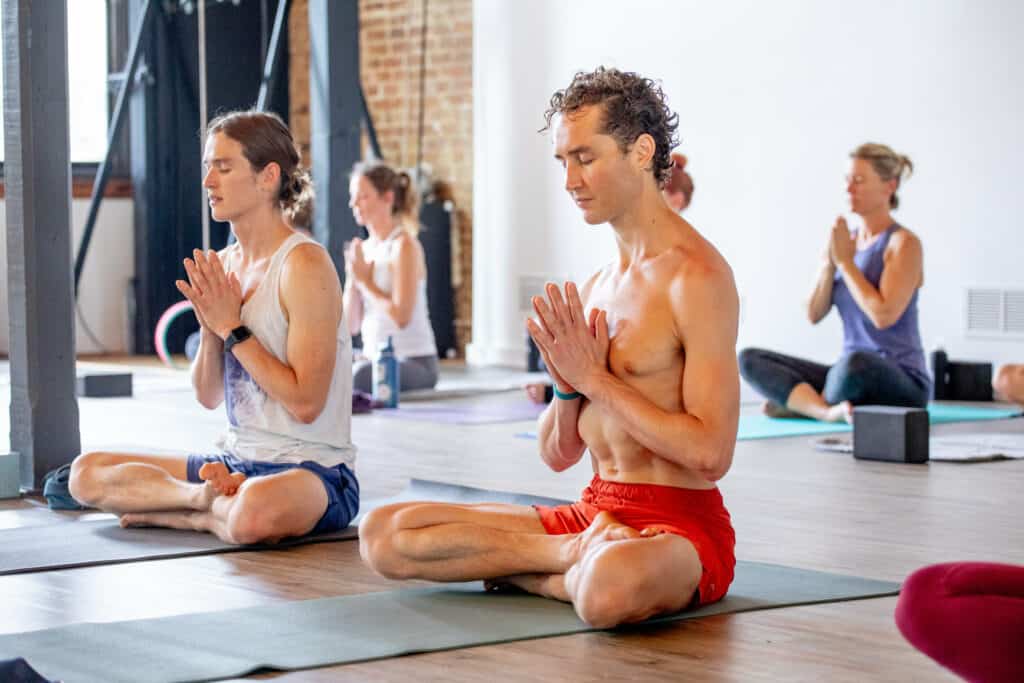
The history of hot yoga
Hot yoga and Bikram yoga are similar, although not completely the same.
Bikram yoga was first introduced to the West in the 1970s, by its “founder” Bikram Choudhury. He emigrated from India to the United States and opened a yoga studio with what is later known as “hot yoga” practice.
The Bikram yoga is a set of 26 poses and 2 breathing exercises done in the same order every time, in a space heated to 105°F (41°C) and with 40% humidity. The practice itself is demanding and it raises heart rate and muscle-flexing. This type of practice can be overwhelming for some people, especially in the beginning stage of practice.
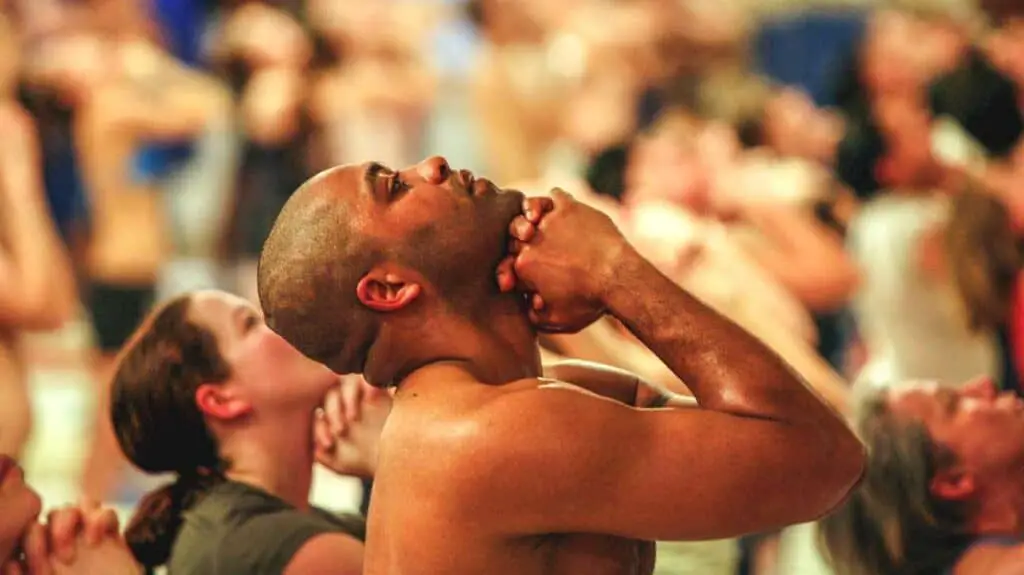
The interchange and mixing of the two terms (Bikram yoga and hot yoga) arouse due to Bikrams’ assault allegations. A lot of studios removed the name Bikram from their services and changed it into heated yoga or hot yoga.
Hot yoga is intensive, even though not as much as Bikram yoga. That makes it hard for some people to keep up and practice it. The next section is dedicated to the health risks of practicing hot yoga, so make sure that you check them out before enrolling in a hot yoga class.
Also, check with your medical doctor for any health risks that might arise or worsen if you do practice hot yoga.
Who shouldn’t practice hot yoga?
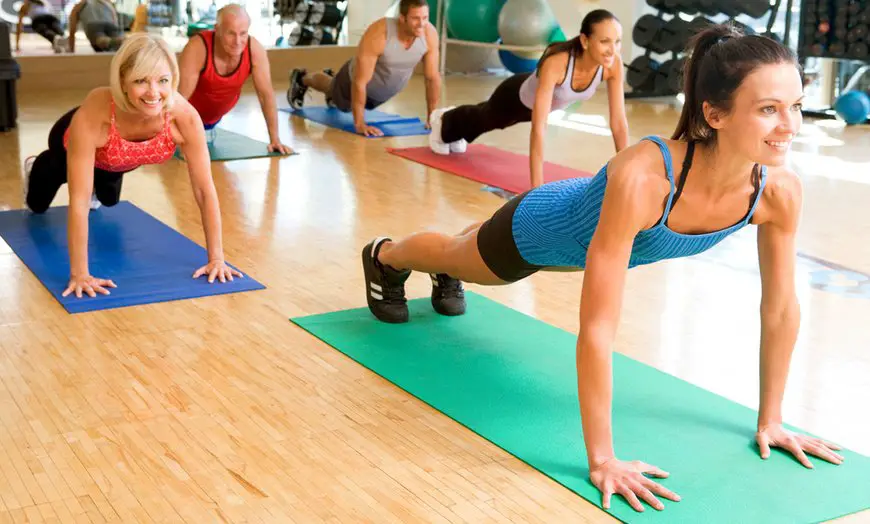
By practicing yoga in a hot and humid atmosphere, some people might have problems breathing, sweating, and blood pressure.
Hot yoga can be harmful to:
- People that suffer from low blood pressure
- People with any kind of heart condition or diseases
- People with high negative reactions to heat
- People with high heat intolerance or heat-related illness as heatstroke
- People with medical conditions that shouldn’t be exposed to a lot of humidity
- People with breathing difficulties
- People prone to dehydration
- People with diabetes
- Pregnant women
If you have any of the previously mentioned conditions, it might be best to skip hot yoga and go for something milder.
As Insider suggests, some research didn’t show any significant health risks for people who practiced hot yoga, while other research found some small correlation. The baseline is that people that are prone to any of the previously mentioned conditions should approach hot yoga with caution.
Make sure that you practice hot yoga under supervision, especially in the early stage. With the intensity that hot yoga provokes, you need to be sure that you can endure it and avoid strains or injury.
If you don’t have any health concerns and do want to practice hot yoga, make sure that you drink plenty of water in your everyday life. This is especially important before, during, and after a hot yoga workout, since there will be a lot of sweating and dehydration during hot yoga practice.
Hot yoga benefits
The primal benefit of hot yoga, as with any other type of yoga, is to relax the mind and improve the physical body by combining breathing techniques, asanas (yoga poses), and meditation.
In the first hot yoga, the high temperature, and humidity were meant to represent the weather conditions of India, the birthplace of yoga. Later on, the heated environment of hot yoga has proved to make yoga more challenging, while also providing a more active atmosphere for exercising and lowering body weight.
Aside from these main benefits, there are a few more positive outcomes of hot yoga practice:
Improved flexibility and muscle toning
The atmosphere in a hot yoga studio allows practitioners to stretch and bend easily since the heat relaxes the muscles and adds motion range. This is especially true for the lower back, hamstrings, and shoulders.
Since mobility is increased in a heated atmosphere, hot yoga is also more effective in muscle toning than other kinds of yoga.
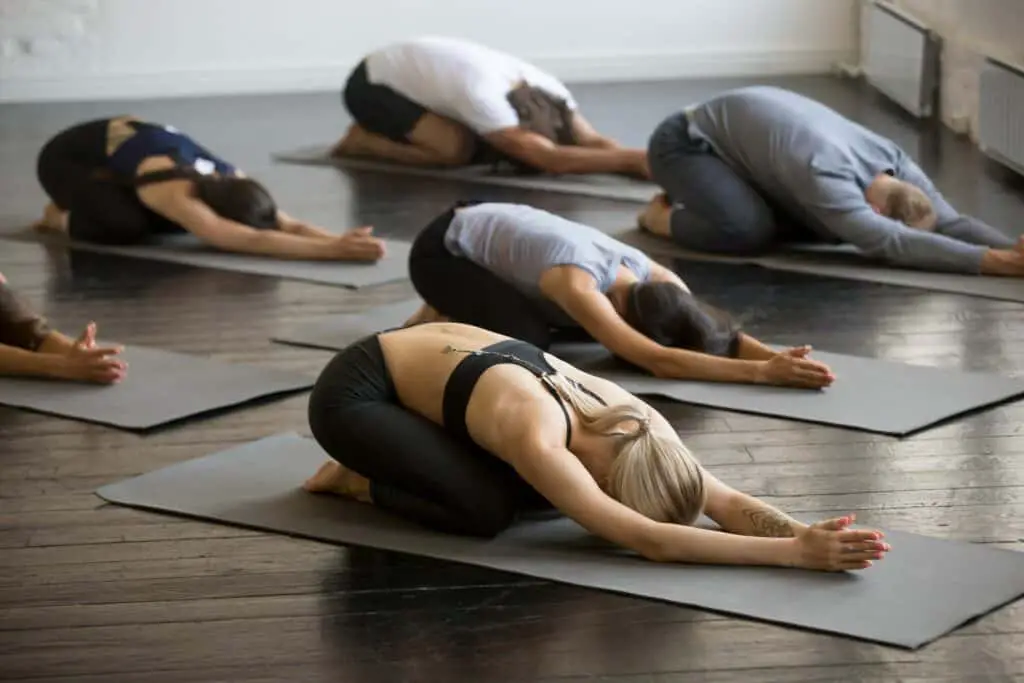
Improved bone density
Research done in the past decade has shown that with regular Bikram yoga, bone density in the neck, lower back, and hips is increased. That is achieved through the strength practitioners put to support their bodies while in a pose. This is especially important for older people and women close to menopause.
Reducing stress
Every kind of yoga is known to reduce stress, mainly by including yoga breathing techniques and some kinds of meditation and present moment awareness.
By getting in and coming out of asanas, practitioners also report more self-esteem, since they become aware of their ability to control their body (thus their life) and be able to withstand pressure.
Lowers depression and depressive moods
Research has shown that yoga relaxes and improves mood. Numerous new studies are continuously reporting at least some degree of reduced depressive symptoms.
Heart boost
Doing yoga poses in a heated, humid atmosphere will give your heart, lungs, and muscles more exercise. It also helps with respiration and faster metabolism.
But, before enrolling in hot yoga classes to improve your heart rate, make sure that you don’t have any threatening cardiovascular conditions since you might bring your body to overclocking.
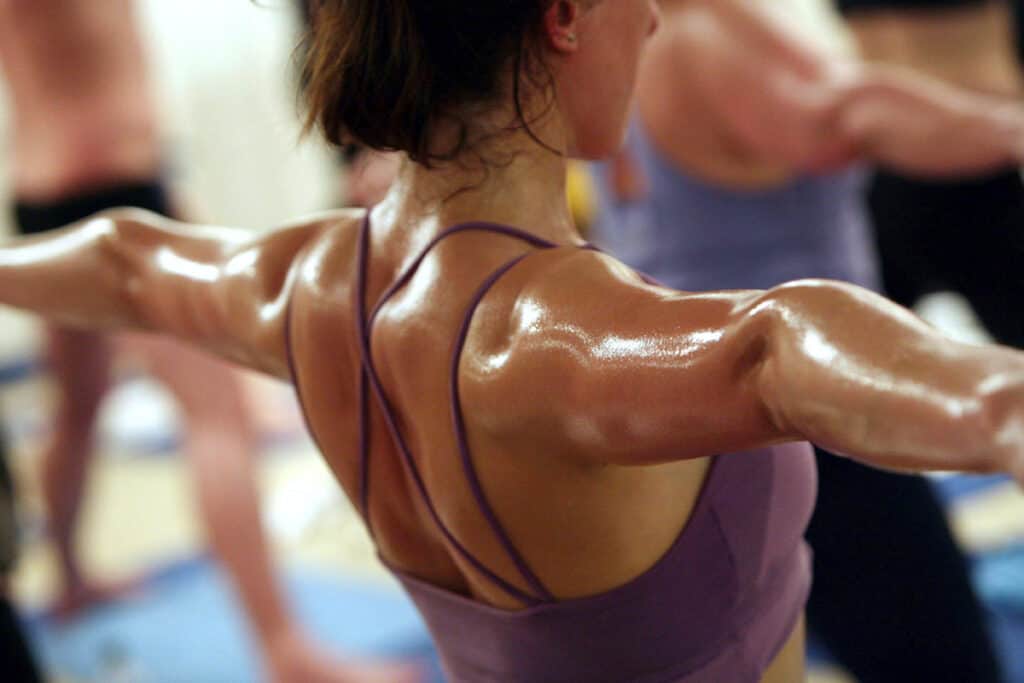
Reducing Cholesterol
Aside from helping with heart work, hot yoga has shown to also lower cholesterol levels in the blood. With the combination of faster heart rate, more breathing, and open blood vessels, hot yoga aids the whole body, just as any other kind of exercise does.
Lowers Glucose levels in the blood
Sugar in the blood, in the form of glucose, can be lowered in the bloodstream by any kind of exercise. Burning more energy enables this process, so hot yoga practitioners with risks of developing type 2 diabetes can benefit greatly.
Nourishes your skin
During sweating (as with hot yoga), your body receives more oxygen and a higher pace of blood circulation. With that, skin cells receive oxygen-enriched blood faster, a process that nourishes the skin.
Hot yoga for weight loss
Because hot yoga is done in a warm (hot) atmosphere, it aids the loss of weight in a couple of ways.
As we previously mentioned, hot yoga increases the calories burned during a session. It increases heart rate and lowers cholesterol levels while eating up glucose from the bloodstream. All these aspects help with weight loss.
Heat also relaxes the muscles, making them more flexible. So, a person can do the poses efficiently, stretching a little further than what they would’ve been able to do at a regular temperature. This increased flexibility can also allow the person to participate in other physical activities that can further aid weight loss.
Sweating is another important aspect of hot yoga which enables the body to detox by releasing toxins through the skin. With deep breathing, the body receives more oxygen and improved blood circulation.
Aside from the physical positive effects that hot yoga has for weight loss, it also helps the practitioner in their mental health. For one, it increases body-mind awareness for practitioners i.e. become more in contact with their body and decide to make better decisions about their health and diet. Due to its intensity, it also provokes more water intake, something that is crucial for a faster metabolism.
Lastly, aligning body-mind parts helps participants to become aware of the “control” they have over their body, while also noting every small improvement they do in asanas. This, transfers in order aspects of life, so hot yoga practitioners are more likely to feel in control of their bodies and gain confidence that they can improve themselves and their bodies.
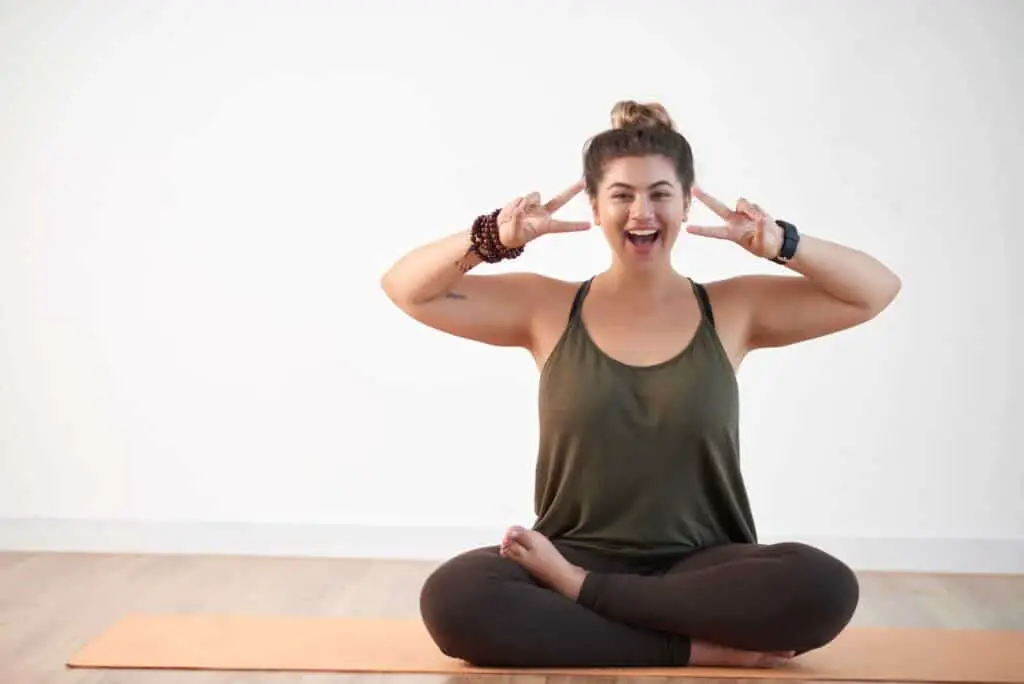
How many calories does hot yoga burn?
Due to higher temperatures, getting the body positioned in different asanas helps burn more calories. With Bikram yoga, practitioners burn as much as two times more calories than regular yoga. To be exact, during a 90-minute Bikram yoga practice, men can lose up to 460 calories, while women can burn up to 330 calories. The numbers for 60-minutes of regular hatha yoga are 180 calories.
Hot yoga practitioners, in general, lose less than with Bikram, but the number is still higher than with traditional hatha yoga.
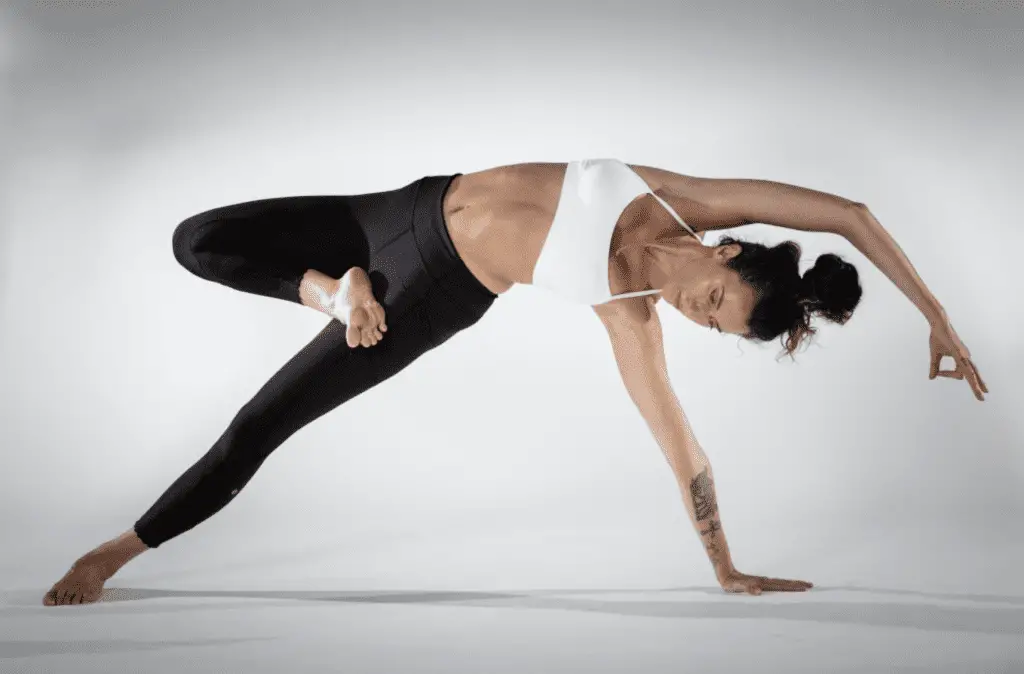
Safety tips for beginners
If you don’t have any experience with got yoga and you’ve only seen it online, you might feel a little bit intimidated before trying it out.
Don’t give up right away and prepare yourself beforehand for the first class. After a couple of classes, you will become more comfortable and will be able to easily learn and follow poses.
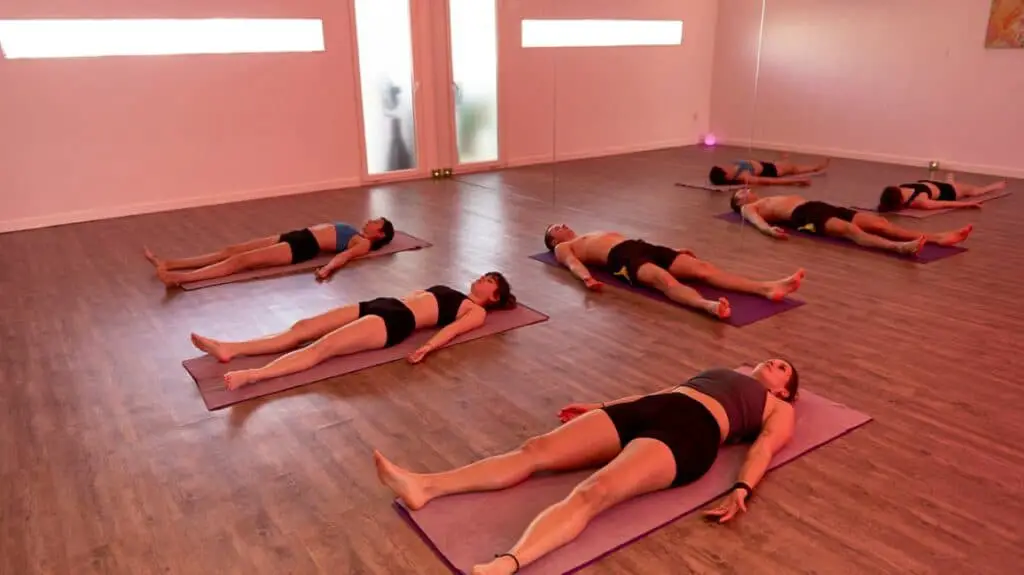
Wear suitable outfit
During a hot yoga class, you will most certainly be hot and start sweating. It is the point of it, isn’t it?
So, wear a suitable outfit – tank top, sports bra, T-shirt with light-weight capris or shorts should be good. You can also wear a headband to stop sweat from getting in your eyes. You won’t need any footwear or socks, since hot yoga, as well as any other kind of yoga, is practiced barefoot on a yoga mat.
Stay hydrated
Drinking a lot of water the day before hot yoga class will ensure that you have enough fluids in your body to sweat without dehydrating. I underline “the day before hot yoga class” since drinking a lot of water minutes before your class starts will only burden your abdomen.
It’s also important to stay hydrated on the day of the hot yoga class, but be sure that you will have time to release any excess water and only be left with a highly hydrated body during the class.
Also, it would be a very good idea to take a couple of bottles of water with you in class. That way, you can always refresh yourself if you start feeling lightheaded or dehydrated.
Don’t put heavy fragrances on your body
Having a lot of fragrances, perfumes, or lotions during hot yoga class might overwhelm your senses and make you uncomfortable. Strong smells draw attention, so you might be unable to concentrate. Or, you might break your class members’ concentration. Plus, applying lotions on your skin before hot yoga class might clog your pores and make it harder for your skin to sweat and breathe.
Don’t overeat
Don’t eat too much before your hot yoga class. Working out with your stomach full might be a problem for you and make you feel uncomfortable (unfortunately, even make you sick.)
So, go easy on the meals and eat 2 to 3 hours before class. If you get hungry in the meantime, go for something light like fruit, nuts, or healthy bar snacks.
Get there a little bit early
If this is your first time going to a hot yoga class, you should be there early. It will give you time to adjust and get comfortable in the space (and the temperature!), ask any questions you might have, fill in any paperwork needed, and get acquainted with other class members.
Even if this isn’t your first class, it’s nice to get to the yoga studio a little early – to acclimate yourself to the temperature, calm down and get ready for the class.
Prepare mentally and let the moment guide you
Hot yoga might look a little bit overwhelming at the beginning. To calm down and get a certain boost in confidence, you should research a little bit more about hot yoga, maybe look at a few videos. There is a perfect example in the next section. Maybe you can start from there?
Also – leave your mind open. You won’t easily flow from one pose to another at the beginning, but with consistency and dedication, you will master the poses very soon. Yoga classes are meant to bring you in contact with yourself and your body, so be present.
What to expect at a hot yoga class?
To answer this question, I advise you to take a look at the YouTube video of the same name. Keltie O’Connor – a sports enthusiast and famous YouTuber, together with Angela from Metta Yoga Studio, explain all the basics of a hot yoga class.
These are the things you can expect from your first hot yoga class:
- Expect to sweat a lot
- Expect to learn yoga poses that might take a while until you do them properly
- Expect to learn a lot of helpful breathing techniques
- Expect your heart to beat faster and for you to breathe faster
- Expect to get quite exhausted
- Expect sore muscles the next day
- Expect to drink a lot of water
- Expect to meet a lot of new people and have fun!
Hot Yoga FAQ:
What is the point of hot yoga?
The point of hot yoga is to exercise the mind and body, relax and bring balance to the practitioners’ life. Hot yoga is also good for losing weight since the hot atmosphere that it’s practiced in allows for more sweating and a more intense workout.
What is the difference between classical yoga and hot yoga?
The main difference between classical hatha yoga and hot yoga is the atmosphere it is practiced in. Hot yoga is done in a room with anywhere between 80 and 100°F (27 and 38°C) and with a lot of humidity. The poses and the breathing techniques in classical and hot yoga are more or less the same.
Can a beginner do hot yoga?
Yes, a beginner can do hot yoga. But, you need to be cautious not to overwork yourself. Take your time, if you need to stop and rest at a certain time, feel free to do so. Drink a lot of water and don’t eat too much before practice.
Conclusion
Hot yoga is a term used to describe yoga classes done in studios with higher temperatures and more humidity.
Hot yoga has numerous benefits, but since it can get quite exhausting it’s not recommended for people who have heart or breathing conditions. For those who can practice hot yoga, there are a lot of benefits – from better flexibility down to losing weight.
If you are a new hot yoga enthusiast, don’t be afraid to give it a go!
If you can think of anything I might’ve missed in the article, feel free to add or ask in our comments section.

